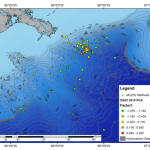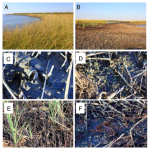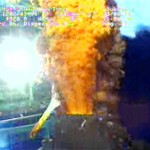Two important Gulf of Mexico stories catching my attention this week.
First off, dives to a deep-sea coral reef appear to bring back good news–coral communities appear unaffected and life still appears to be flourishing despite the site being only 20 miles from the blown-out Macondo well.
Sandra Brooke, coral conservation director at the Marine Conservation Biology Institute, [says]…”We have to be careful with our conclusions about this kind of data,” Brooke said, noting it will take more than just a few dives to determine the extent of the damage. “We’ll take further analysis but from what we’ve seen so far, it seems like they’ve dodged a bullet.”…The corals’ reproduction rates will be studied over the coming weeks, she said.
However, this cautiously optimistic news comes amidst more and more reports of oil coating deep sediments in the Gulf.
Scientists on the research ship Cape Hattaras found oil in samples dug up from the seafloor in a 140-mile radius around the site of the Macondo well, said Kevin Yeager, a University of Southern Mississippi assistant professor of marine sciences. Oil found in samples ranged from light degraded oil to thick raw crude, Yeager said.
A research team on a ship called the Arctic Sunrise, sponsored by the environmental activist group Greenpeace, also turned up traces of oil in sediment samples as well as evidence of chemical dispersants in blue crab larvae and long plumes of oxygen-depleted water emanating from the well site 50 miles off Louisiana’s coast.
But NOAA still vehemently denies that have found any evidence of oil in the deep-sea…some have even questioned whether they know what they’re doing, and whether this could be seriously skewing results:
Debbie Payton, a NOAA oceanographer leading the agency’s subsurface oil monitoring, said NOAA scientists have detected an oily sheen in some of the sediments samples they’ve taken near the well site, but early results from lab analysis so far have not shown any oil particles. Part of the discrepancy between federal and academic scientists may come from how NOAA scientists lower the multi-ton machinery used to collect the samples, known as a “multiple corer,” into the sea, said Samantha Joye, a University of Georgia marine sciences professor who was one of the first to discover oily sediment in the seafloor. Lowering the multiple corer too fast could disrupt the fine sediment on the seafloor and disperse oil particles, she said. “These are really fine layers,” Joye said. “If you don’t know what you’re doing, you’re not going to find oil.”
All stuff to make you think.
And P.S. I STILL haven’t been able to get my hands on any of these 1081819 samples they keep talking about in these news stories. PLEASE SEND ME SAMPLES, NOAA! YOU SAID YOU WOULD :(






One Reply to “More reports of oil in the deep, but corals seem OK”
Comments are closed.